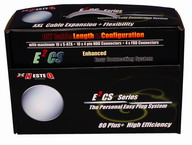|
NESTEQ ECS7001 700W POWER SUPPLY UNIT
 |
NesteQ's E²CS Series of modular power supply, whose acronym stands for " Enhanced Easy Connecting System". From the initial look of this unit, you see what looks to be a common modular power supply, but the fine designers at NesteQ have thought ahead and have come up with an easy answer to one of the most basic problems that many of us have when routing our cables through our computer cases, especially the case modders who strive to make everything look neat and tidy. NesteQ have won many awards with their E²CS series of power supplies, no doubt to the innovative features and strength of these finely built power supplies. Everything from their excellent packaging to their instruction and specification manual included indicate that this is a company that takes attention to details.
Background on PSU Rails:
Years ago, Intel’s ATX specifications indicated to all of us that a voltage of 240VA (equal to 240W DC) was much too high for a single DC output rail to be real "safe." Meaning that the 240VA on one +12V rail is equal to 20A. So the new specifications indicated that if more than 20A was required for a +12V rail, then the +12V load could be split-up across multiple rails, each of +12V. Splitting up the 20A or more across multiple rails actually helps in more ways than merely to make the power supply “safer”, Intel also specified that the extra +12V rail should be used for the CPU, or separate from its' peripherals on a +12V1, because the other devices might add electronic "noise" to the DC output side of the power supply. The devices that can add noise are things such as the fans, lights, hard drive motors, etc... So by isolating the +12V2 from the +12V1, the CPU in effect gets less electronic or in essence, “cleaner” power distribution.
This specification and knowledge led to power supplies evolving from a single +12V rail design, to power supplies with dual +12V rails, then tri (three) +12V rails and the currently sought after quad (four) +12V rails. For anyone who is not familiar with many of the technical aspects associated with the specifications on power supply units, the quickest way to gauge the output performance quality of a power supply is to look at the specifications listed on the +12V rails. These rails serve as the primary source of power to the processor and is crucial for system stability and performance, especially if you plan on over clocking. While there isn't an exact specification on these numbers, generally it is best to purchase a unit with a 15 Amp or greater (the higher the better) max current specification on the +12V rail. On some higher-end power supply's this number will usually be in the range of 20A or more.
Background on Power Supply Efficiency Ratings:
PC's use a large amount of power currently. As the CPU's and internal devices evolve to become more powerful, this translates directly into the amount of power they require to run effectively. The issue that many energy conscious consumers are noticing is that even if your system has a 400W power supply, the amount of power that it is actually pulling is usually much greater, with some of this extra-power being drawn wasted because of the power supply's lack of efficiency.
As AC power is drawn into your power supply from the wall socket, it converts this power from the 110V AC from the wall socket down to the voltages required by your computer to run normally, which in general are 3.3V DC, 5V DC and 12V DC. This drop from high power AC voltage to a much lower DC voltage leads to power waste or loss as the voltage is converted and generally manifests itself in the form of heat generated inside of the power supply. This is also why most every power supply currently available has at least one fan to cool the internal components and keep it from burning up, or reaching too high of a heat index.
Efficiency ratings on power supply's let you know how much energy is wasted or lost during this conversion process from AC power to DC power in your system. A good example of this would be, if your computer system has a 400W power supply and let's say the manufacturer indicates that it has a 75% efficiency rating, this means that this power supply would draw 533W of AC power from your wall socket, in order to convert it down to the indicated 400W or 400W divided by .75 (75%) would give us 533W.
In steps the EPA and establishes the Energy Star system for indicating energy efficient products and then this system evolves in to what is now required to meet the Energy Star system. New power supplies must now meet an 80% efficiency rating across all rated power output to be considered to wear the Energy Star label. This basically means that regardless if your computer system is running at 5%, 50% or up to 100%, the power supply must reach and maintain a minimum of 80% efficiency rating. Based upon this knowledge we always suggest to our readers that when making a decision on a new power supply, that you take the time to look for a unit that shows the 80 Plus+ logo on it, which means that the power supply has been thoroughly tested and approved to meet the Energy Star specifications for efficiency and in our current energy conscious "think green" times this adds up.
REAL TIME PRICING ON THERMALTAKE TOUGHPOWER




